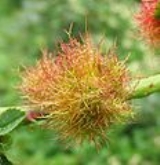
Rose bedeguar gall
Encyclopedia
The Rose bedeguar gall, Robin's pincushion gall, or Moss gall
develops as a chemically induced distortion of an unopened leaf axillary or terminal buds mostly on Field Rose (Rosa arvensis) or Dog rose
(Rosa canina) shrubs, caused by the parthenogenetic hymenopteran gall wasp
(Diplolepis rosae (Linnaeus, 1758)), previous synonyms are D. bedeguaris, Rhodites rosae or Cynips rosae.
Diplolepis lay up to sixty eggs within each leaf buds using their ovipositor
. The asexual wasp emerges in spring; less than one percent are males.
A similar gall is caused by Diplolepis mayri, but this is much less common.
, bād-āwar, meaning 'wind-brought.' Robin in Robin's pincushion refers to the woodland sprite
of English folklore, Robin Goodfellow.
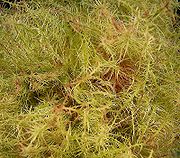
 The bedeguar gall is surrounded by a dense mass of sticky branched filaments. This structure gives the appearance of a ball of moss and its filaments are often brightly coloured, being at their best in around September; starting off green and then passing through pink and crimson to reddish brown. A large specimen can be up to 10 cm in width. The larvae develop and then over winter as pupae in the now brown and dry looking structure, emerging in May. The unilarval chambers are set in a woody core which persists after the filaments have worn off.
The bedeguar gall is surrounded by a dense mass of sticky branched filaments. This structure gives the appearance of a ball of moss and its filaments are often brightly coloured, being at their best in around September; starting off green and then passing through pink and crimson to reddish brown. A large specimen can be up to 10 cm in width. The larvae develop and then over winter as pupae in the now brown and dry looking structure, emerging in May. The unilarval chambers are set in a woody core which persists after the filaments have worn off.
The bedeguar may also develop on Rosa rubiginosa, R. dumalis, or R. rubrifolia.
The gall induced by D. mayri differs in being more sparsely covered in short, unbranched filaments and the galls usually develop on the twigs.
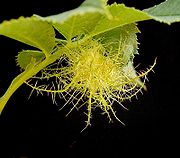
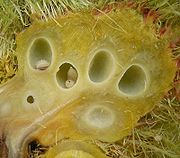 A week after the egg has been laid, the larva hatches and begins to feed on the leaf bud tissue. This activity stimulates (in a way not yet understood) the development by the host plant of enlarged 'nutritive' cells in the area around the growing larva. These are fed on by the larva and are continually replaced by new cells. Further concentric layers of tissues develop around the core nutritive tissue and come to form the structure known as the bedeguar, complete with the outermost and characteristic fibrous outgrowths that give the gall its alternative name of Robin's Pin Cushion. As the larva feeds and grows within this gall, it probably undergoes five larval instar stages (the growth stages between moults. The final instar stage is reached by late October. The larva ceases feeding. It now passes into the prepupal stage, in which form it overwinters inside the gall. In the following February or March the prepupa undergoes a final moult and becomes a pupa. Through the thin transparent skin of the pupa it is possible to see the fully formed antennae, legs, wings and body segments of the adult wasp. As stated earlier, the adult wasps which start to emerge from the Rose bedeguar will be mostly female, and these females will go on to lay eggs through parthenogenesis. The adults begin to emerge from the old galls, which are still attached to the rose, in May. Emergences may continues through to August. No alternation of generation exists in this species.
A week after the egg has been laid, the larva hatches and begins to feed on the leaf bud tissue. This activity stimulates (in a way not yet understood) the development by the host plant of enlarged 'nutritive' cells in the area around the growing larva. These are fed on by the larva and are continually replaced by new cells. Further concentric layers of tissues develop around the core nutritive tissue and come to form the structure known as the bedeguar, complete with the outermost and characteristic fibrous outgrowths that give the gall its alternative name of Robin's Pin Cushion. As the larva feeds and grows within this gall, it probably undergoes five larval instar stages (the growth stages between moults. The final instar stage is reached by late October. The larva ceases feeding. It now passes into the prepupal stage, in which form it overwinters inside the gall. In the following February or March the prepupa undergoes a final moult and becomes a pupa. Through the thin transparent skin of the pupa it is possible to see the fully formed antennae, legs, wings and body segments of the adult wasp. As stated earlier, the adult wasps which start to emerge from the Rose bedeguar will be mostly female, and these females will go on to lay eggs through parthenogenesis. The adults begin to emerge from the old galls, which are still attached to the rose, in May. Emergences may continues through to August. No alternation of generation exists in this species.
As stated, males are known, but are very rare. One possible reason for this scarcity is the presence of a bacterium named Wolbachia
which is endosymbiotic in the females gametes. A female infected with Wolbachia produces only diploid eggs, when in the cells of the ovaries presumably cause the fusion of the pronuclei, which leads to entirely female progeny. When the females were treated with antibiotics they were then able to produce normal male and female eggs.
insects therefore create their own microhabitats by forming, in this case, a highly distinctive plant structure called a gall
, made up of plant tissue, but controlled by the insect. Galls act as both the habitat, and food sources for the maker of the gall. The interior of a bedeguar gall is formed from the bud, and is composed of edible nutritious and structural tissues. Some galls act as "physiologic sinks", concentrating resources in the gall from the surrounding plant parts. Galls may also provide the insect with some physical protection from predators.
Predators, inquilines, parasites, hyperparasite
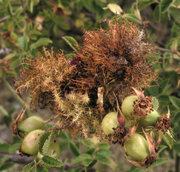
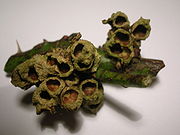 Mature galls are sometimes broken open by vertebrate predators to recover the larvae or pupae. The large size of the emergence holes of the individual cells sometimes suggests that predation by birds or small mammals has taken place (See photo).
Mature galls are sometimes broken open by vertebrate predators to recover the larvae or pupae. The large size of the emergence holes of the individual cells sometimes suggests that predation by birds or small mammals has taken place (See photo).
The bedeguar is a good example of a complex community of insects. The cynipid wasp Periclistus brandtii is an inquiline
that lives harmlessly within the bedeguar gall and like Diplolepis rosae itself, is often parasitised by insects referred to as parasitoids or even by hyperparasitoids in some cases.
The gall-wasp Periclistus brandtii causes no gall itself, but deposits its eggs in the bedeguar tissues on which the larvae feed. In turn these larvae may be parasitised by a chalcid wasp, Eurytoma rosae, which works its way from one inquiline's cell to the next. The parasitoid ichneumon Orthopelma mediator lays its eggs directly into larvae of D. rosae, killing them. The chalcid wasps Eurytoma rosae and Glyphomerus stigma can attack both the larvae of D. rosae and of the inquiline P. brandtii. These parasitoids may in turn be attacked by hyperparasitoids such as the chalcids Caenacis inflexa and Pteromalus bedeguaris. It is clear that the mossy and sticky filaments of the gall are ineffective against preventing the entry of inquilines, predators, parasitoids and hyperparasitoids.
The tissues of the bedeguar gall are frequently attacked by the parasitic fungus Phragmidium subcorticum, more so than the other parts of the host rose plant.
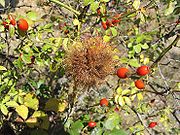 The galls occur more commonly on plants that are under stress, i.e. very dry conditions, waterlogging or hedge cutting, whereas vigorously growing plants are less commonly found to have galls. Whether the vigorous plant suppresses gall formation or is avoided by the wasp in favour of easier targets is unknown. Young and damaged plants tend to produce larger and more numerous than old and intact ones. Many eggs are laid but the number of galls formed is relatively few.
The galls occur more commonly on plants that are under stress, i.e. very dry conditions, waterlogging or hedge cutting, whereas vigorously growing plants are less commonly found to have galls. Whether the vigorous plant suppresses gall formation or is avoided by the wasp in favour of easier targets is unknown. Young and damaged plants tend to produce larger and more numerous than old and intact ones. Many eggs are laid but the number of galls formed is relatively few.
The relative number of parasitoids decreases with increasing gall volume. The vertical distance between gall and soil affects the total number of emerged specimens. The distances from margins of shrubs does not affect nor the parasitoid ratio of galls, neither the volume of the galls. It seems better for a female D. rosae, to induce larger galls on the lower branches of the shrubs in order to increase the survival probability of the offsprings.
Removing and destroying galls before they dry and the wasps emerge may help to reduce the infestation. While fairly large, and sometimes present in quite large numbers on scrub specimens, they cause no measurable harm.
, as a Diuretic
and as a remedy against toothache; the ashes mixed with honey and applied to the scalp were thought to prevent baldness. It was also valued as an Astringent
and for its ability to control fluid loss; placed beneath a pillow it was thought to induce sleep.
develops as a chemically induced distortion of an unopened leaf axillary or terminal buds mostly on Field Rose (Rosa arvensis) or Dog rose
Dog Rose
Rosa canina is a variable scrambling rose species native to Europe, northwest Africa and western Asia....
(Rosa canina) shrubs, caused by the parthenogenetic hymenopteran gall wasp
Gall wasp
Gall wasps , also called Gallflies, are a family of the order Hymenoptera and are classified with the Apocrita suborder of wasps in the superfamily Cynipoidea...
(Diplolepis rosae (Linnaeus, 1758)), previous synonyms are D. bedeguaris, Rhodites rosae or Cynips rosae.
Diplolepis lay up to sixty eggs within each leaf buds using their ovipositor
Ovipositor
The ovipositor is an organ used by some animals for oviposition, i.e., the laying of eggs. It consists of a maximum of three pairs of appendages formed to transmit the egg, to prepare a place for it, and to place it properly...
. The asexual wasp emerges in spring; less than one percent are males.
A similar gall is caused by Diplolepis mayri, but this is much less common.
Terminology
Being so prominent and interesting in appearance this gall has more folklore attached to it than most. The term 'Bedeguar, Bedegar or Bedequar' comes from a French word, bédegar, and is ultimately from the PersianPersian language
Persian is an Iranian language within the Indo-Iranian branch of the Indo-European languages. It is primarily spoken in Iran, Afghanistan, Tajikistan and countries which historically came under Persian influence...
, bād-āwar, meaning 'wind-brought.' Robin in Robin's pincushion refers to the woodland sprite
Sprite (creature)
The term sprite is a broad term referring to a number of preternatural legendary creatures. The term is generally used in reference to elf-like creatures, including fairies, and similar beings , but can also signify various spiritual beings, including ghosts. In Eoin Colfer's Artemis Fowl books,...
of English folklore, Robin Goodfellow.
The physical appearance of Diplolepis rosae
The females insects are about 4mm / 0.2in long; parts of their abdomens and legs are yellow-red, while the rest of the body is black. The male is black and lacks the hypopygium structure which clearly identifies the species in the female. Its legs are bi-coloured yellow and has a body length of about 3mm.The physical appearance of the Rose bedeguar gall


The bedeguar may also develop on Rosa rubiginosa, R. dumalis, or R. rubrifolia.
The gall induced by D. mayri differs in being more sparsely covered in short, unbranched filaments and the galls usually develop on the twigs.
Life-cycle


As stated, males are known, but are very rare. One possible reason for this scarcity is the presence of a bacterium named Wolbachia
Wolbachia
Wolbachia is a genus of bacteria which infects arthropod species, including a high proportion of insects , as well as some nematodes. It is one of the world's most common parasitic microbes and is possibly the most common reproductive parasite in the biosphere...
which is endosymbiotic in the females gametes. A female infected with Wolbachia produces only diploid eggs, when in the cells of the ovaries presumably cause the fusion of the pronuclei, which leads to entirely female progeny. When the females were treated with antibiotics they were then able to produce normal male and female eggs.
Gall forming insects
Some herbivorousHerbivore
Herbivores are organisms that are anatomically and physiologically adapted to eat plant-based foods. Herbivory is a form of consumption in which an organism principally eats autotrophs such as plants, algae and photosynthesizing bacteria. More generally, organisms that feed on autotrophs in...
insects therefore create their own microhabitats by forming, in this case, a highly distinctive plant structure called a gall
Gall
Galls or cecidia are outgrowths on the surface of lifeforms caused by invasion by other lifeforms, such as parasites or bacterial infection. Plant galls are abnormal outgrowths of plant tissues and can be caused by various parasites, from fungi and bacteria, to insects and mites...
, made up of plant tissue, but controlled by the insect. Galls act as both the habitat, and food sources for the maker of the gall. The interior of a bedeguar gall is formed from the bud, and is composed of edible nutritious and structural tissues. Some galls act as "physiologic sinks", concentrating resources in the gall from the surrounding plant parts. Galls may also provide the insect with some physical protection from predators.
Predators, inquilines, parasites, hyperparasiteHyperparasiteA hyperparasite is a parasite whose host is a parasite. This form of parasitism is especially common among entomophagous parasites....
s and fungi


The bedeguar is a good example of a complex community of insects. The cynipid wasp Periclistus brandtii is an inquiline
Inquiline
In zoology, an inquiline is an animal that lives commensally in the nest, burrow, or dwelling place of an animal of another species. For example, some organisms such as insects may live in the homes of gophers and feed on debris, fungi, roots, etc...
that lives harmlessly within the bedeguar gall and like Diplolepis rosae itself, is often parasitised by insects referred to as parasitoids or even by hyperparasitoids in some cases.
The gall-wasp Periclistus brandtii causes no gall itself, but deposits its eggs in the bedeguar tissues on which the larvae feed. In turn these larvae may be parasitised by a chalcid wasp, Eurytoma rosae, which works its way from one inquiline's cell to the next. The parasitoid ichneumon Orthopelma mediator lays its eggs directly into larvae of D. rosae, killing them. The chalcid wasps Eurytoma rosae and Glyphomerus stigma can attack both the larvae of D. rosae and of the inquiline P. brandtii. These parasitoids may in turn be attacked by hyperparasitoids such as the chalcids Caenacis inflexa and Pteromalus bedeguaris. It is clear that the mossy and sticky filaments of the gall are ineffective against preventing the entry of inquilines, predators, parasitoids and hyperparasitoids.
The tissues of the bedeguar gall are frequently attacked by the parasitic fungus Phragmidium subcorticum, more so than the other parts of the host rose plant.
Infestations of Rose bedeguar galls

The relative number of parasitoids decreases with increasing gall volume. The vertical distance between gall and soil affects the total number of emerged specimens. The distances from margins of shrubs does not affect nor the parasitoid ratio of galls, neither the volume of the galls. It seems better for a female D. rosae, to induce larger galls on the lower branches of the shrubs in order to increase the survival probability of the offsprings.
Removing and destroying galls before they dry and the wasps emerge may help to reduce the infestation. While fairly large, and sometimes present in quite large numbers on scrub specimens, they cause no measurable harm.
Medicinal uses of Rose bedeguar galls
Dried and powdered it was used as to cure ColicColic
Colic is a form of pain which starts and stops abruptly. Types include:*Baby colic, a condition, usually in infants, characterized by incessant crying*Renal colic, a pain in the flank, characteristic of kidney stones...
, as a Diuretic
Diuretic
A diuretic provides a means of forced diuresis which elevates the rate of urination. There are several categories of diuretics. All diuretics increase the excretion of water from bodies, although each class does so in a distinct way.- Medical uses :...
and as a remedy against toothache; the ashes mixed with honey and applied to the scalp were thought to prevent baldness. It was also valued as an Astringent
Astringent
An astringent substance is a chemical compound that tends to shrink or constrict body tissues, usually locally after topical medicinal application. The word "astringent" derives from Latin adstringere, meaning "to bind fast"...
and for its ability to control fluid loss; placed beneath a pillow it was thought to induce sleep.
See also
- Knopper gallKnopper gallAndricus quercuscalicis is a gall wasp species inducing Knopper galls.Knopper galls develop as a chemically induced distortion of growing acorns on Pedunculate Oak trees, caused by gall wasps, which lay eggs in buds with their ovipositor...
- Oak marble gallOak marble gallOak marble galls develop as a chemically induced distortion of leaf buds on pedunculate oak , or sessile oak trees, caused by the parthenogenetic gall wasp which lays eggs within leaf buds using their ovipositor...
- Oak appleOak appleOak apple is the common name for a large, round, vaguely apple-like gall commonly found on many species of oak. Oak apples range in size from 2-5cm. Oak apples are caused by chemicals injected by the larva of certain kinds of gall wasp in the family Cynipidae. The adult female wasp lays single...
- GallGallGalls or cecidia are outgrowths on the surface of lifeforms caused by invasion by other lifeforms, such as parasites or bacterial infection. Plant galls are abnormal outgrowths of plant tissues and can be caused by various parasites, from fungi and bacteria, to insects and mites...
- Oak artichoke gallOak artichoke gallOak artichoke galls, oak hop galls, larch-cone galls or hop strobiledevelop as a chemically induced distortion of leaf axillary or terminal buds on Pedunculate Oak or Sessile Oak trees, caused by the parthenogenetic gall wasp Andricus fecundator, which lays single eggs within leaf buds using...
- Pineapple gall
- Rhabdophaga rosariaRhabdophaga rosariaRhabdophaga rosaria is a gall midge which forms Camellia galls or terminal rosette gall on willow species.-Description:Willows are extremely susceptible to gall induction and growth manipulation and Salix is one of the plant genera with the highest known numbers of associated galler species.The...
- Eriophyes tiliae

